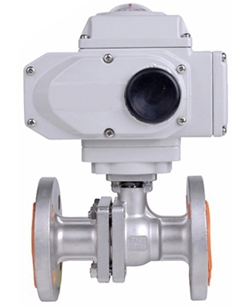What Causes the Leakage of Electric Ball Valve?
The electric ball valve is driven by an electric actuator and has the action of rotating 90°. It is mainly used for cutting, distributing and changing the moving direction of the medium. The electric ball valve has the characteristics of compact structure, stable performance and convenient installation. It has been used more and more in many industries. It can be operated on site or controlled remotely. It is one of the final control elements in the field of automatic control. Electric ball valves may leak during use or installation. Next, let's learn about the reasons for electric actuated ball valve leakage and how to deal with them.
Reasons for leakage of electric ball valve during construction period
 Improper transportation and hoisting cause the overall damage of the electric ball valve and cause the electric ball valve to leak.
Improper transportation and hoisting cause the overall damage of the electric ball valve and cause the electric ball valve to leak.- When leaving the factory, the electric ball valve was not dried and treated with anti-corrosion after the water pressure was applied, which caused the sealing surface to corrode and leak.
- The protection of the construction site is not in place, and the two ends of the electric ball valve are not equipped with blind plates, and impurities such as rainwater and sand enter the valve seat, causing leakage.
- During installation, no grease was injected into the valve seat, which caused impurities to enter the back of the valve seat, or burns during welding to cause leakage.
- The valve is not installed in the fully open position, causing damage to the ball. During welding, if the valve is not in the fully open position, the welding spatter will cause damage to the ball. When the ball with welding spatter is opened and closed, it will further cause damage to the valve seat, resulting in leakage.
- Construction residues such as welding slag cause scratches on the sealing surface.
- Inaccurate limit position at the time of delivery or installation causes leakage. If the valve stem drive sleeve or other accessories are assembled at the wrong angle, the ball valve will leak.
Reasons for leakage of electric ball valve during operation
- The electric ball valve does not carry out preventive maintenance, which causes the equipment to fail in advance.
- Improper operation or failure to follow maintenance procedures to cause leakage.
- During normal operation, construction residues scratch the sealing surface and cause leakage.
- Improper pigging will damage the sealing surface and cause leakage.
- The electric ball valve is not maintained or inactive for a long time, which will cause the valve seat and the ball to lock, and the sealing damage will cause leakage when opening and closing the electric ball valve.
- The electric ball valve switch is not in place to cause leakage. Any electric ball valve, regardless of the open or closed position, generally tilts 2° to 3°, which may cause leakage.
- Many large-diameter electric ball valves have valve stem stoppers. If they are used for a long time, rust, dust, paint and other debris will accumulate between the valve stem and the valve stem stopper due to corrosion and other reasons. These debris will cause The electric ball valve cannot rotate in place and causes leakage - if the electric ball valve is buried, the lengthening of the valve stem will produce and fall more rust and impurities that prevent the ball from rotating into place, causing the electric ball valve to leak
- The general actuator also has a limited position. If it is rusted for a long time, the hardening of the grease or the loosening of the limit bolt will make the limit inaccurate and cause leakage.
- The valve position of the electric actuator is set to the front, and it is not closed in place to cause leakage.
- The lack of periodic maintenance and maintenance causes the sealing grease to dry and harden, and the dried sealing grease accumulates behind the elastic valve seat, hindering the valve seat movement, resulting in seal failure.
How to deal with electric ball valve leakage?
- Check the limit position of the electric ball valve to see if the leakage of the electric ball valve can be solved by adjusting the limit position.
- Inject a certain amount of grease first to see if it can stop the leakage. At this time, the injection speed must be slow, and at the same time, observe the change of the pointer of the pressure gauge at the outlet of the grease injection gun to determine the leakage of the electric ball valve.
- If the leakage cannot be stopped, it may be caused by the hardening of the sealing grease injected in the early stage or the damage of the sealing surface. It is recommended to inject the electric ball valve cleaning fluid at this time to clean the sealing surface and valve seat of the electric ball valve. Generally, it is soaked for at least half an hour, if necessary, it can be soaked for several hours or even a few days. In this process, it is best to switch the movable electric ball valve several times.
- Re-inject the grease, open and close the electric ball valve intermittently, and discharge the impurities out of the back cavity of the valve seat and the sealing surface.
- Check at the fully closed position. If there is still leakage, inject reinforced sealing grease, and open the valve cavity to vent, which can generate a large pressure difference and help seal. In general, by injecting reinforced sealing grease leaks can be eliminated.

